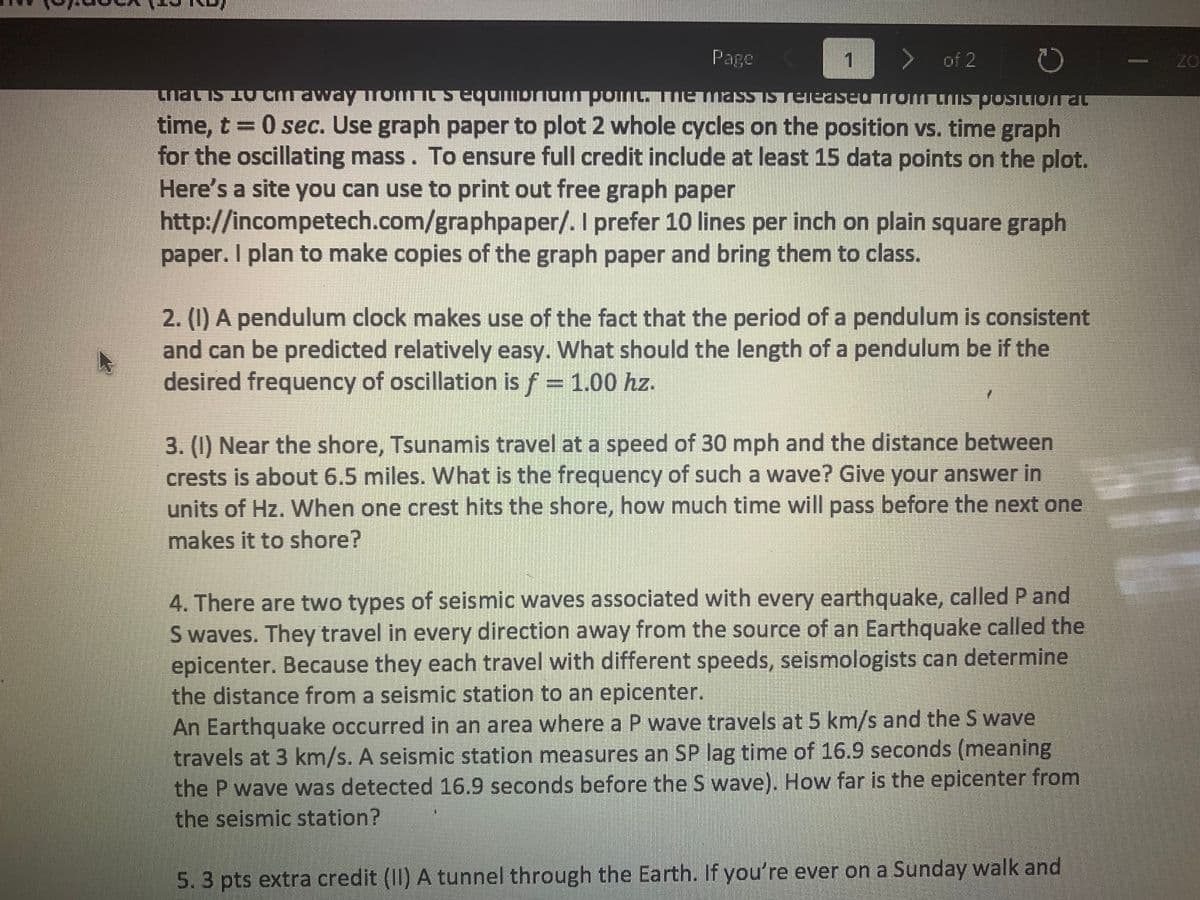4. There are two types of seismic waves associated with every earthquake, called P and S waves. They travel in every direction away from the source of an Earthquake called the epicenter. Because they each travel with different speeds, seismologists can determine the distance from a seismic station to an epicenter. An Earthquake occurred in an area where a P wave travels at 5 km/s and the S wave travels at 3 km/s. A seismic station measures an SP lag time of 16.9 seconds (meaning the P wave was detected 16.9 seconds before the S wave). How far is the epicenter from the seismic station?
4. There are two types of seismic waves associated with every earthquake, called P and S waves. They travel in every direction away from the source of an Earthquake called the epicenter. Because they each travel with different speeds, seismologists can determine the distance from a seismic station to an epicenter. An Earthquake occurred in an area where a P wave travels at 5 km/s and the S wave travels at 3 km/s. A seismic station measures an SP lag time of 16.9 seconds (meaning the P wave was detected 16.9 seconds before the S wave). How far is the epicenter from the seismic station?
Classical Dynamics of Particles and Systems
5th Edition
ISBN:9780534408961
Author:Stephen T. Thornton, Jerry B. Marion
Publisher:Stephen T. Thornton, Jerry B. Marion
Chapter12: Coupled Oscillations
Section: Chapter Questions
Problem 12.9P
Related questions
Question
please answer # 4

Transcribed Image Text:Page
1.
of 2
time, t = 0 sec. Use graph paper to plot 2 whole cycles on the position vs. time graph
for the oscillating mass. To ensure full credit include at least 15 data points on the plot.
Here's a site you can use to print out free graph paper
http://incompetech.com/graphpaper/. I prefer 10 lines per inch on plain square graph
paper. I plan to make copies of the graph paper and bring them to class.
2. (1) A pendulum clock makes use of the fact that the period of a pendulum is consistent
and can be predicted relatively easy. What should the length of a pendulum be if the
desired frequency of oscillation is f = 1.00 hz.
3. (1) Near the shore, Tsunamis travel at a speed of 30 mph and the distance between
crests is about 6.5 miles. What is the frequency of such a wave? Give your answer in
units of Hz. When one crest hits the shore, how much time will pass before the next one
makes it to shore?
4. There are two types of seismic waves associated with every earthquake, called P and
S waves. They travel in every direction away from the source of an Earthquake called the
epicenter. Because they each travel with different speeds, seismologists can determine
the distance from a seismic station to an epicenter.
An Earthquake occurred in an area where a P wave travels at 5 km/s and the S wave
travels at 3 km/s. A seismic station measures an SP lag time of 16.9 seconds (meaning
the P wave was detected 16.9 seconds before the S wave). How far is the epicenter from
the seismic station?
5.3 pts extra credit (II) A tunnel through the Earth. If you're ever on a Sunday walk and
Expert Solution
This question has been solved!
Explore an expertly crafted, step-by-step solution for a thorough understanding of key concepts.
Step by step
Solved in 2 steps

Knowledge Booster
Learn more about
Need a deep-dive on the concept behind this application? Look no further. Learn more about this topic, physics and related others by exploring similar questions and additional content below.Recommended textbooks for you

Classical Dynamics of Particles and Systems
Physics
ISBN:
9780534408961
Author:
Stephen T. Thornton, Jerry B. Marion
Publisher:
Cengage Learning

Physics for Scientists and Engineers: Foundations…
Physics
ISBN:
9781133939146
Author:
Katz, Debora M.
Publisher:
Cengage Learning

Principles of Physics: A Calculus-Based Text
Physics
ISBN:
9781133104261
Author:
Raymond A. Serway, John W. Jewett
Publisher:
Cengage Learning

Classical Dynamics of Particles and Systems
Physics
ISBN:
9780534408961
Author:
Stephen T. Thornton, Jerry B. Marion
Publisher:
Cengage Learning

Physics for Scientists and Engineers: Foundations…
Physics
ISBN:
9781133939146
Author:
Katz, Debora M.
Publisher:
Cengage Learning

Principles of Physics: A Calculus-Based Text
Physics
ISBN:
9781133104261
Author:
Raymond A. Serway, John W. Jewett
Publisher:
Cengage Learning

Physics for Scientists and Engineers, Technology …
Physics
ISBN:
9781305116399
Author:
Raymond A. Serway, John W. Jewett
Publisher:
Cengage Learning

Glencoe Physics: Principles and Problems, Student…
Physics
ISBN:
9780078807213
Author:
Paul W. Zitzewitz
Publisher:
Glencoe/McGraw-Hill

University Physics Volume 1
Physics
ISBN:
9781938168277
Author:
William Moebs, Samuel J. Ling, Jeff Sanny
Publisher:
OpenStax - Rice University